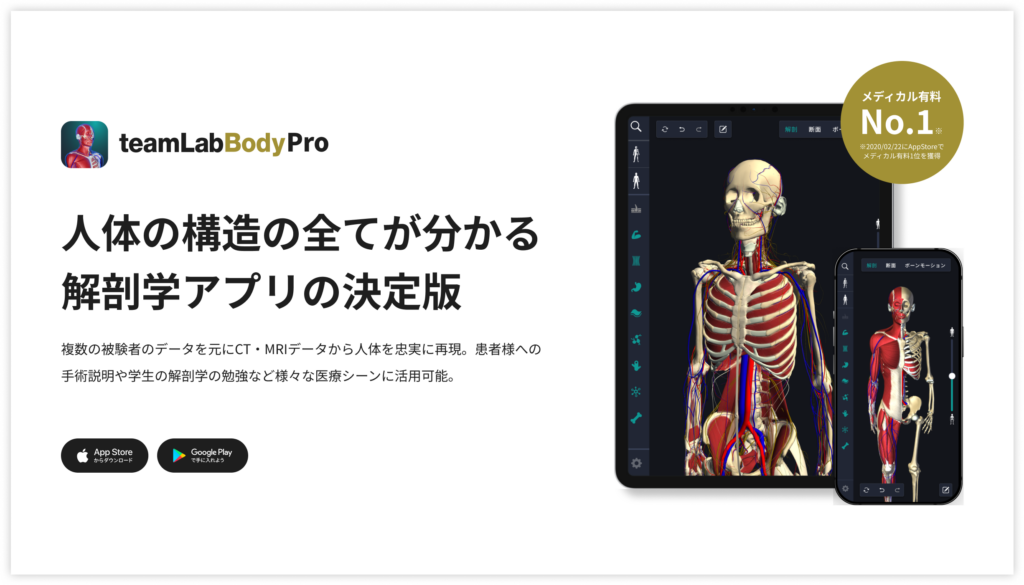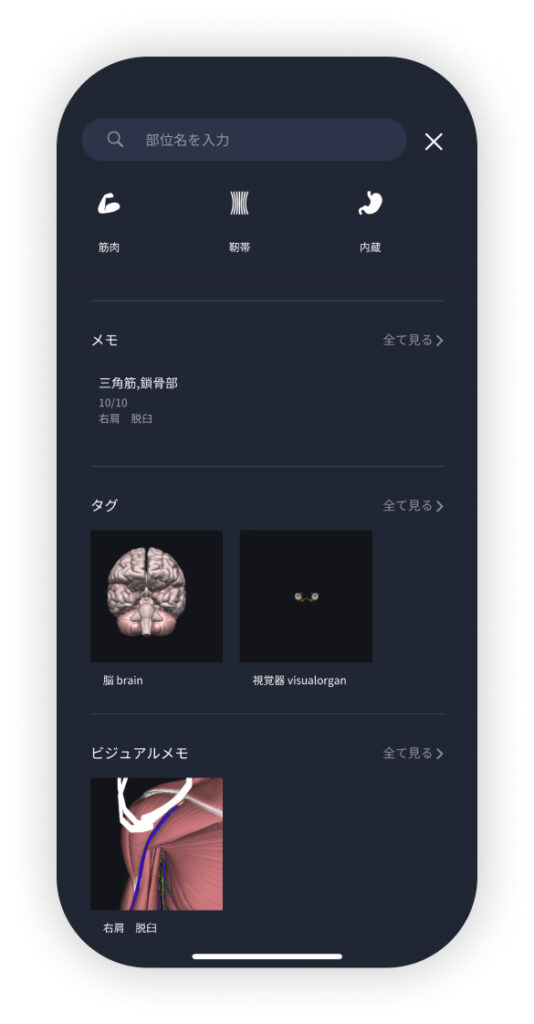beginning
In this article, I will explain effective study methods, starting with knowledge of specialized parts in human anatomy.
In human anatomy, it is necessary not only to memorize the names of various organs, muscles, and bones, but also to remember where they are located in the body. Therefore, it is necessary to learn as efficiently as possible.
I hope you will deepen your understanding even a little by reading this article and using the app.
Now, I'll explain the details about the “intertransverse ligament” and how to study human anatomy.
teamLab Body Pro Free Download
A 3D anatomy app that shows all the structures of the human body
Download teamLab Body Pro here!

What is the intertransverse ligament?
The anatomy application allows you to view a selection of anatomy 3D models. In this model, there are various observation methods such as surfaces, cross-sections, and nervous systems. This time, I'll explain using an anatomy application.
About intertransverse ligament

The supra-axial ligament (supra-axial ligament) is a part of the ligament between the cervical vertebrae and has a structure that connects adjacent transverse processes.
This ligament plays an important role, particularly from C1 (annular) to C2 (axial spine), and contributes to stability and mobility of the cervical spine. The superior intertransverse ligament not only supports neck rotation and flexion in coordination with other ligaments, but also has a restrictive function to prevent excessive neck movement.
In particular, it functions as an important structure that controls rapid rotation and extension of the neck. In addition, this ligament also stabilizes the back of the spine and prevents compression of the spinal cord and nerve roots. Clinically, damage to the superior intertransverse ligament can cause cervical spine instability and cause neck pain, movement restrictions, and even neurological symptoms.
Study points
Anatomical understanding: ligament location and coordination
The superior transverse intervertebral ligament is of the cervical spineC1 to C2It runs on, connects the lateral protrusions of each vertebra, and supports the rotational movement of the neck. First, anatomically,transverse processIt is important to understand how they are arranged and how the superior intertransverse ligament connects between them. You can deepen your understanding by visually checking the shape of the lateral protrusions and the positional relationship of the ligaments using a 3D anatomy app or human model. When studying, keep track of how the C1 and C2 vertebrae work together to support neck movement. What is superior intertransverse ligamentRotation or flexion of the cervical spineSince it has an effect, it is basic to firmly hold down that anatomical position.
Functional understanding: motor control and stabilization
As a functional role of superior intertransverse ligament,Restrictions on neck rotation or flexionYou can list them. In particular, it works to maintain neck stability against excessive rotation and rapid movements. When learning, it is important to actually turn your neck or tilt it back and forth to experience what range of movement is restricted. Also, in order to understand how ligaments protect the neck,Neck stability and range of motionIt's a good idea to think about balance. In particular, it is important to understand how damage to the superior transverse ligament causes cervical instability and the mechanisms by which neurological symptoms occur as a result.
Practical application: clinical understanding and treatment
The superior transverse ligament is very important when clinically evaluating cervical stability. In particular, the cervical spineTrauma and degenerative diseases(For example,cervical spondylosis or hernia), when this ligament is damaged, compression of the spinal cord and nerve roots is more likely to occur.neurological symptomsSince (for example, neck pain, numbness, hand paralysis, etc.) appear, understanding superior intertransverse ligament damage or compression is essential for diagnosis. When learning this, it is important not only to obtain anatomical knowledge, but also to understand how the superior intertransverse ligament is involved through medical examinations and diagnostic imaging (X-rays, MRI) in clinical cases. Also, in treatment, in order to maintain neck stabilityrehabilitativeandImprove postureSince surgical intervention may be necessary in some cases, it is also important to learn clinical approaches.
How to study human anatomy
I will explain specific study methods using human anatomy applications.
Check your past learning history and practice repeatedly
Here are the steps to check your anatomy learning history and practice iteratively effectively.
1. Check your learning history in the app
Reviewing your learning history with the application is an important step in effectively advancing anatomy learning. First, launch the app and go to the learning history section from the main menu. Many anatomy apps are designed to show your progress in the form of graphs and lists, so you can visually check which parts you've learned about and how much time you've spent.
By using this data, you can understand which areas you have strengths in and where you need to spend more time and effort. We also recommend using a dedicated tag or notebook function to mark areas you are particularly weak at or where you need to relearn. Regularly checking your learning history and looking back on past learning content will lead to efficient review and deepening understanding.
2.Make a plan for iterative learning
Making an efficient repetitive learning plan based on learning history is extremely effective in promoting knowledge retention. First, identify weak points and areas where you need to relearn. Next, arrange these study items into a weekly or monthly calendar and create a specific study schedule. By proceeding in a planned manner, you can learn each part evenly and avoid packing in a large amount of information at once.
Using a task management app or digital calendar to set study reminders is effective. Also, it's important to have the flexibility to regularly review progress and revise plans as needed. By having goals and proceeding with your studies in a planned manner, you can efficiently acquire anatomical knowledge.
3.Use 3D features to learn visually
By utilizing the 3D function, learning anatomy is easier to understand visually. The 3D model shows the structure of the human body three-dimensionally, and each part can be observed in detail. This makes it possible to intuitively grasp positional relationships between deep muscles and organs that are difficult to capture in a planar view. For example, you can learn even the smallest details by rotating specific muscles and bones and zooming in and out.
Also, there are many apps that have the function of displaying cross-sectional views of each part using a 3D model, which is useful for deepening understanding of internal structures. This diversity of visual information helps with memory retention and improves immediate responsiveness in tests and practice situations. By utilizing the 3D function and learning visually, you can learn anatomy knowledge more deeply and efficiently.
Use the memo function concretely

Make notes so you don't forget the things and points you've noticed while studying. The memo function can be used for different purposes, such as inputting text, saving images, and writing memos. Tag your notes to make them easier to review later.
Test your learning regularly in the form of quizzes
Regularly testing what you've learned in a quiz format is a very effective way to anchor your anatomy knowledge. Quiz-style tests help you objectively grasp your level of understanding and areas you lack while repeating knowledge.
For example, by using a learning app to conduct quizzes every specific period, you can reconfirm what you've learned and strengthen your memory. There are a wide range of quiz formats, such as multiple choice questions, fill-in-the-blank questions, and short answer questions, and each helps understanding from a different angle and develops the ability to utilize various types of knowledge.
Get feedback
If possible, get feedback from other learners and experts. It helps you find your own gaps in understanding and areas for improvement. You can also keep yourself motivated to learn by regularly testing yourself. Feeling a sense of accomplishment and progress increases motivation for continuous learning.
summary
This time, I explained how to study about the “intertransverse ligament” using an application!
Thank you for reading this far.
I would be happy if reading this article helped you learn about anatomy.
Learning is a long, never-ending journey, but I sincerely wish you all the best. Let's continue to study together and work hard for the national exam!
Please look forward to the next blog.
teamLab Body Pro Free Download
A 3D anatomy app that shows all the structures of the human body
Download teamLab Body Pro here!





